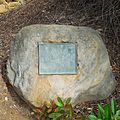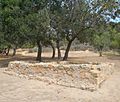Mission Park, Santa Barbara facts for kids
Quick facts for kids Mission Historical Park |
|
|---|---|

Grassy area of Mission Historical Park in Santa Barbara looking northeast toward the Santa Ynez Mountains
|
|
| Location | Intersection of East Los Olivos St. and Laguna St. in Santa Barbara, California; Due east of the Santa Barbara Mission |
| Area | 10 acres (4 ha) |
| Created | 1928-1948 |
| Operated by | City of Santa Barbara Parks & Recreation Department |
| Website | Mission Historical Park |
Mission Historical Park is a 10-acre park in Santa Barbara, California. It sits just east of the famous Mission Santa Barbara. This park has many cool features. You'll find a big grassy field, the A.C. Postel Memorial Rose Garden, and a fountain. There are also hiking trails and many sycamore and oak trees.
The park also includes a historic olive grove, dedicated to World War I veterans. You can see old remains of tannery vats and a pottery. There's also a gristmill and an old reservoir with an aqueduct system. Both the park and the Mission became a California Historical Landmark on July 12, 1939.
A main road, Alameda Padré Serra, divides the park. About 9,900 cars use this road every day. The southern part of the park is 8 acres. It stretches from East Los Olivos Street and Laguna Street north to Alameda Padré Serra. The smaller northern part is 2 acres. It is located between Alameda Padré Serra and Mountain Drive.
Contents
Park History: How Mission Historical Park Began
After the 1925 Santa Barbara earthquake, the Mission Santa Barbara needed repairs. The Franciscan Fathers, who owned the land, decided to sell a part of it. This piece of land was about 7.8 acres. It went from Laguna and East Los Olivos Streets north to Alameda Padré Serra.
On June 30, 1928, the City Council agreed to buy this land. They paid $37,000 for it, using money from private donations. By 1939, the city had paid a total of $53,068.80. This amount included interest and other costs. In 1940, a plan for the park was approved.
In 1948, the Franciscan Fathers gave the rest of the park land to the City. This was the 2-acre section between Alameda Padré Serra and Mission Ridge Road.
In 1954, the City planned to make Los Olivos Street straighter through the park. But local people and groups strongly disagreed. In March of that year, the City Council changed the park's name. It went from "Mission Plaza" to "Mission Historical Park." This name had been suggested by Pearl Chase five years earlier. By 1970, city officials wanted to redesign the park and nearby streets again.
A.C. Postel Memorial Rose Garden
The A.C. Postel Memorial Rose Garden is a special garden. It is recognized by the All-America Rose Selections (AARS). The garden started in 1955 with a gift of 500 rose bushes. In 1959, the Santa Barbara Rose Society was formed. This group helps take care of the roses.
By 1961, the rose garden was not looking good. The Rose Society asked to help manage it. In the years that followed, many new rose bushes were planted. In 1971, the Little Garden Club added a special fragrance garden for people who are blind.
In the late 1970s, funding for parks was cut. This happened because of 1978 California Proposition 13. The full-time gardener for the roses was no longer there. Volunteers tried to help, but the garden still got worse. In 1980, some people even thought about replacing the roses with tennis courts.
However, in 1982, a group was formed to save the rose garden. By 1984, a fund called the Virginia Firth Wade Endowment Fund donated $35,000. This was part of the $51,000 needed to fix the garden. The only condition was that the garden be renamed the A.C. Postel Memorial Rose Garden.
Today, the garden has over 1,500 rose plants. It is one of more than 130 special rose gardens in the U.S. It shows off many types of roses, including AARS winners. A yearly grant of $5,000 helps maintain the garden. This money pays for a part-time gardener, watering, and feeding the plants.
The rose garden is a popular spot for weddings. There are two main areas for ceremonies. A large grassy section on the west side can hold up to 200 people. A smaller area on the north end, near Plaza del Rubio Street, can hold up to 50 people.
Rose Collections: Beautiful Varieties in the Garden
The garden grows many different types of roses. Some of these are recognized by the All-America Rose Selection Committee (AARS). Examples include Chicago Peace (1962), China Doll (AARS 1946), and Color Magic. You can also find Double Delight, Duet (AARS 1961), and Iceberg. Other popular roses are Just Joey, Over The Moon, and Peace.
Some roses are named after famous people. These include Barbra Streisand (AARS 2000) and Henry Fonda (AARS 1995). You can also see the Julia Child rose (2004) and Marilyn Monroe (AARS 2003).
The garden also has very old types of roses. These include Gallicas, Albas, and Damasks. There are also Old Garden Roses and Hybrid Perpetuals. These were first grown in the 1800s. You can also see Chinas like Mutabulis and Old Blush, which dates back to 1752.
Grassy Area: A Historic Orchard Site
The park's large grassy area covers about half of the original 8-acre section. This land was sold to the City in 1928.
In 1840, this area was a three-acre orchard. It had pear, apple, apricot, and fig trees. This orchard was about 100 yards in front of the Mission. Today, this is where the grassy area meets East Los Olivos Street. By the early 1900s, most of the orchard trees were gone.
"The fruit trees gradually died or were removed, until fifteen years ago there were only three standing. Now there is but one, which is still vigorous, though its bark is moss covered and its branches are much overgrown."
—Hawley, Walter A., The Early Days of Santa Barbara California, 1909
A six-sided wall surrounded the orchard. This wall was strong, with heavy stone supports. Parts of the northern and eastern sections of this wall were still standing between 1910 and 1920.
Historical Waterworks and Production Facilities
Many of the old structures in the park were built by the Chumash people. They often worked for the California Missions. This was part of the Mission industry system of that time. Here are some of these important facilities and what they were used for.
Upper Reservoir and Grist Mill
Around 1827, a water-powered gristmill and a reservoir were built. Chumash people built these under the direction of Fr. Antonio Ripoll. The reservoir was shaped like a hexagon. It was made of sandstone, paved with bricks, and covered with pink plaster.
The ruins of the 31-foot grist mill are still there. Signs in the park explain how water flowed into the mill. A wooden gate controlled the water. Then, a special clay pipe sent water downwards. It flowed at a 35-degree angle against the mill's water wheel. This made the wheel spin, powering the millstones to grind grain into flour. After leaving the mill, the water went to the lower reservoir. From there, it was used to water fields, orchards, and the fountain.
Filter House
Next to the upper reservoir, you can see the ruins of a filter house. This building cleaned water for people to use. Water flowed through a mix of charcoal and sandstone. This process purified it. Then, the clean water traveled through an aqueduct to the lower reservoir.
Lower Reservoir
In 1806, a square stone reservoir was built. It was part of a system to bring water to the Mission's orchards and gardens. This reservoir was 7 feet deep and covered an area of 110 square feet. It could hold about 535,000 gallons of water.
This reservoir is located north of Alameda Padre Serra, within Mission Park. It was so well-built that the City used it for water storage until 1993. Then, it became part of Mission Historical Park.
Aqueduct
In 1807, a dam and aqueduct system were built in Mission Canyon. This system supplied water to the people living at the Mission. One dam was built across the west fork of Mission Creek. This was about 1.5 miles north of the Santa Barbara Mission. Another dam was built across the east fork of the creek, about 3 miles from the Mission. A part of the lower aqueduct wall still stands today. You can see it north of the grassy area in the park.
Tannery
The Tannery had large stone vats. These vats held special chemicals. They were used to turn animal hides into leather. This leather was then used to make things like horse saddles, shoes, and other leather goods.
Pottery
The Pottery building is located just north of where Alameda Padre Serra and East Los Olivos Street meet. It was built in 1808. Here, Chumash workers made tiles, water pipes, and cooking pots. In 1914, part of the pottery was destroyed. This happened to make way for the Alameda Padre Serra roadway.
Gallery
-
View of the Santa Barbara Mission from the Rose Garden
-
Northerly view of a Santa Ynez peak from the park.




















